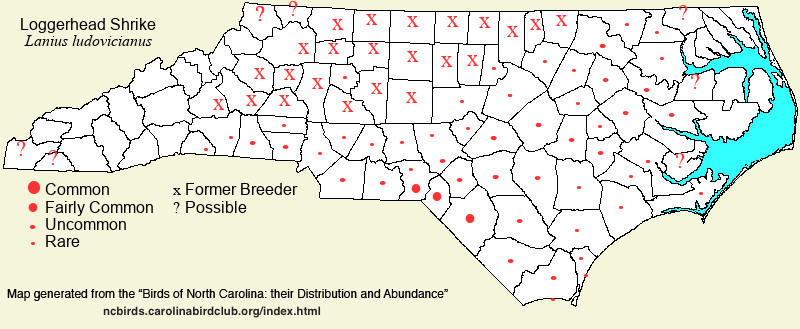 |  |
|
Loggerhead Shrike - Lanius ludovicianus LANIIDAE Members: | Search Common: Search Scientific: |
|
|
|||||||
| General Comments | The Loggerhead Shrike was historically rare to absent as a breeding species in the East, but with the opening up of the forests for farmland, it, the Eastern Meadowlark, and the Brown-headed Cowbird moved in from the Midwest as nesting species. However, starting in the 1970's, the shrike has undergone a steep population decline over most of its range, and many states have it on their rare species list. The decline can be attributed to loss of farmland to development and succession (as farms are abandoned), cleaner farming practices, perhaps severe winters, and undetermined factors such as prey decline, decline in thorny tree species, use of pesticides, disease, etc. The decline has seemly stopped or slightly slowed in recent years, and birds are even being found slightly farther east in the nesting season than previous seen. Shrikes nest in the western and southern parts of the Coastal Plain, but only sparingly now in the Piedmont; and the wintering range is similar, though there is likely some increase of birds in winter than summer (at least in the Coastal Plain). Favored habitats are extensive pastures and farmland, with thorny trees or shrubs or barbed wire fences (for impaling prey). Sandy soil areas are favored over wetter or more clay-like soils. | ||||||
| Breeding Status | Breeder | ||||||
| NC BRC List | Definitive | ||||||
| State Status | SC | ||||||
| U.S. Status | |||||||
| State Rank | S3B,S3N | ||||||
| Global Rank | G4 | ||||||
| Coastal Plain | Permanent resident, with migratory movements. Nests east to about Roanoke Rapids, Washington, and Wilmington -- thus essentially absent from the northeastern 40% of the region, and also absent in most coastal counties except Brunswick and New Hanover. However, remarkably far to the northeast was an adult seen carrying nesting material near Murfreesboro (Hertford) on 24 Jun 2023. (The species nested in Carteret in 2011, and again in 2021, for perhaps the only time since 1975). Winters over this same range, with a few birds being seen slightly farther east, sporadically to the Lake Mattamuskeet area and to Carteret. Year-round, uncommon to fairly common in counties bordering South Carolina (such as Scotland, Robeson, and Columbus); slightly less numerous in the Sandhills and central counties; rare to uncommon in the northern portions. Peak counts: | ||||||
| Piedmont | Permanent resident, with slightly noticeable migratory movements. Formerly (prior to about 1975) nested over nearly all of the province. Currently, mostly rare to locally uncommon only in counties along the SC border with much farmland, such as Cleveland and Union; otherwise, rare in the southern half, and very rare to absent in the northern half. It no longer nests in counties along the VA border, at least west of Granville, as well as in most central counties, though a confirmed breeding record was noted in Davie in 2023. The wintering range is similar. Peak counts: | ||||||
| Mountains | Transient and winter visitor/resident, and likely former breeder. Now a very rare transient in the lower elevations, and a very rare and local winter visitor -- mainly in Ashe, Alleghany, and Transylvania. There are a few recent summer records, but none for conclusive breeding. Primarily Dec to Mar, but scattered records over the year. Peak counts: 3, New River SP CBC, 21 Dec 1991. | ||||||
| Finding Tips |
Your best bet is to drive secondary roads in Robeson or Scotland counties, where the species is still numerous enough to see a few in a day. Driving roads south from US 74 to the Lumber River SP is a good area. Shrikes can still be seen regularly as far north as Edgecombe, southern Halifax, and Martin in the northwestern Coastal Plain. ** to *** | ||||||
| Attribution | LeGrand[2025-02-04], LeGrand[2023-10-20], LeGrand[2023-03-26] | ||||||
| NC Map Map depicts all counties with a report (transient or resident) for the species. | Click on county for list of all known species. |
| NC Breeding Season Map Map depicts assumed breeding season abundance for the species. |  |